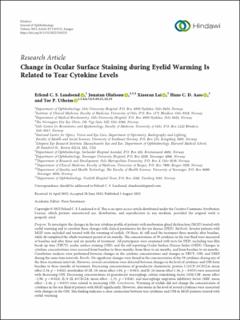| dc.description.abstract | Purpose: To investigate the changes in the tear cytokine profile of patients with meibomian gland dysfunction (MGD) treated with eyelid warming and to correlate these changes with clinical parameters for dry eye disease (DED).
Methods: Seventy patients with MGD were included and treated with the warming of eyelids. Of these, 61 still used the treatment three months after baseline, while 48 completed the whole treatment period of six months. The concentrations of 39 cytokines in the tear fluid were measured at baseline and after three and six months of treatment. All participants were examined with tests for DED, including tear film break-up time (TBUT), ocular surface staining (OSS), and the self-reporting Ocular Surface Disease Index (OSDI). Changes in cytokine concentrations were assessed from baseline to three months, from three to six months, and from baseline to six months. Correlation analyses were performed between changes in the cytokine concentrations and changes in TBUT, OSS, and OSDI during the same time intervals.
Results: No significant changes were found in the concentrations of the 39 cytokines during any of the three treatment intervals. However, several correlations were detected between changes in the level of cytokines and OSS from baseline to three months of treatment. Decreasing concentrations of granulocyte chemotactic protein 2 (GCP-2/CXCL6, mean effect 2.36, p = 0.042), interleukin 10 (IL-10, mean effect 1.04, p = 0.045), and IL-16 (mean effect 1.36, p = 0.035) were associated with decreasing OSS. Decreasing concentrations of granulocyte macrophage colony-stimulating factor (GM-CSF, mean effect −2.98, p = 0.024), IL-8 (IL-8/CXCL8, mean effect −1.35, p = 0.026), and macrophage migration inhibitory factor (MIF, mean effect −2.44, p = 0.033) were related to increasing OSS.
Conclusions: Warming of eyelids did not change the concentration of cytokines in the tear fluid of patients with MGD significantly. However, alterations in the level of several cytokines were associated with changes in the OSS. This finding indicates a close connection between tear cytokines and OSS in MGD patients treated with eyelid warming. | en_US |

